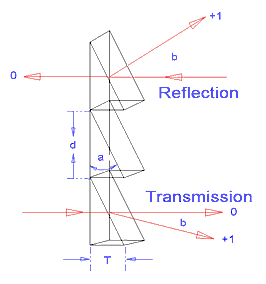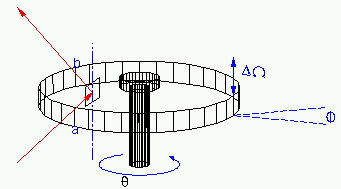Difference between revisions of "Equations"
m |
|||
| (3 intermediate revisions by the same user not shown) | |||
| Line 4: | Line 4: | ||
|[[Image:Sine.gif|left]]<br> | |[[Image:Sine.gif|left]]<br> | ||
| | | | ||
| − | *Max D.E. ~ 30% | + | *Max D.E. ~ 30% ± 1 order |
*Power distribution follows Bessel function in the scaler region. | *Power distribution follows Bessel function in the scaler region. | ||
| − | *T | + | *T ≈ λ for transmission. |
| − | *T | + | *T ≈ λ/4 for reflection. |
*Easily replicated or deep etch can yield higher efficiency. | *Easily replicated or deep etch can yield higher efficiency. | ||
|} | |} | ||
| Line 15: | Line 15: | ||
|[[Image:Square.gif|left]] | |[[Image:Square.gif|left]] | ||
| | | | ||
| − | *Max D.E. ~ 40% | + | *Max D.E. ~ 40% ± 1 order. |
*Power distributions favors odd orders. | *Power distributions favors odd orders. | ||
*Pi phase shift typical. | *Pi phase shift typical. | ||
*Classic binary grating. | *Classic binary grating. | ||
| − | *T | + | *T ≈ λ for transmission. |
| − | *T | + | *T ≈ λ/4 for reflection. |
|} | |} | ||
| Line 29: | Line 29: | ||
*Max D.E ~ 98% | *Max D.E ~ 98% | ||
*Reflection Case: | *Reflection Case: | ||
| − | ** | + | **λ = 2 d sin a |
| − | **T = | + | **T = λ/2 ± 10% |
*Transmission Case: | *Transmission Case: | ||
| − | ** | + | **λ = d sin b |
| − | **a | + | **a ≈ 2b |
| − | **T = | + | **T = λ/(n-1) ± 10% |
| − | **Surface shadows reduce D.E. by | + | **Surface shadows reduce D.E. by <math>\textstyle \frac{\lambda^2}{n d^2}</math> |
| − | **Wavelength changes reduce D.E. by | + | **Wavelength changes reduce D.E. by <math>\textstyle \left(\frac{\pi\Delta\lambda}{b\lambda}\right)^2</math> |
|} | |} | ||
| Line 43: | Line 43: | ||
|[[Image:Scan.gif|left]]<br> | |[[Image:Scan.gif|left]]<br> | ||
| | | | ||
| − | *N = | + | *N = θD/(1.4λ) |
*N = number of resolvable spots | *N = number of resolvable spots | ||
| − | * | + | *θ = full scan angle in radians |
*D = beam diameter in microns | *D = beam diameter in microns | ||
| − | * | + | *λ = wavelength |
| − | * | + | *Φ = wedge angle of glass |
| − | *Special case of linear scan and near wobble invariance | + | *Special case of linear scan and near wobble invariance a ~ b ~ 45° max straight scan angle ~ 36° |
| − | *Dynamic wobble | + | *Dynamic wobble <math>\scriptstyle \simeq \Delta\Omega/128</math> |
| − | *Wedge wobble = (n-1) | + | *Wedge wobble = (n-1)Φ |
| − | *Scan angle multiplier = 1.4 @ | + | *Scan angle multiplier = 1.4 @ 90° cross scan angle |
|} | |} | ||
Latest revision as of 15:05, 12 May 2013
Contents
Common DOE surfaces
Sinusoidal, triangle
|
Square, rectangle
|
Blazed, sawtooth
|
Holographic Deflectors (hologons)
|
Last modified on 9/29/97



